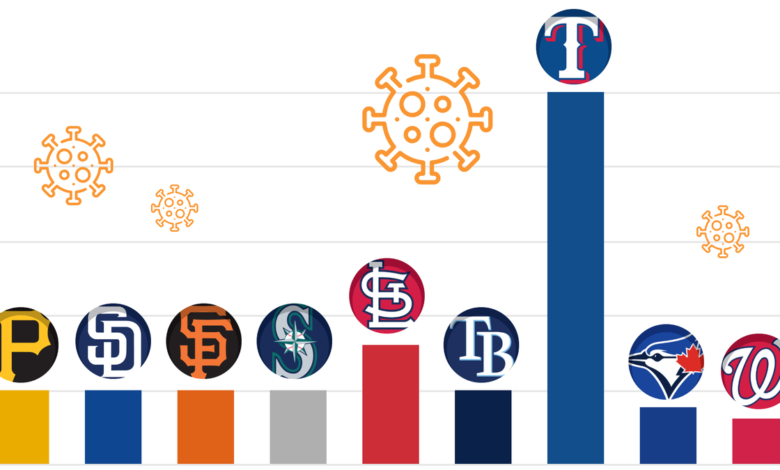

As scientists raise concerns about a potential fourth COVID-19 wave, Major League Baseball teams will open their gates to fans April 1.
The majority will start the season with their stadiums at 20% to 30% capacity, allowing groups to socially distance in the stands. Some are even more conservative: The Nationals, Red Sox and Blue Jays will allow 5,000, 4,500 and 1,275 fans, respectively.
Many have April 5 circled on their calendars: when the Texas Rangers plan to open all 40,300 seats to fans – a decision announced the same day the state's face mask requirement was lifted.
"The Rangers are encouraged that the Governor’s Office has given clearance for us to fully open Globe Life Field at the start of the 2021 Major League Baseball season,” Neil Leibman, the Rangers' president of business operations and chief operating officer, said in a statement announcing the plan.
The Rangers said they will reduce capacity slightly after the opening-day excitement wanes, offering socially distanced seating in four sections of the stadium.
COVID-19 infection rates in each of the counties where the 30 MLB teams play are down substantially from their peaks. Many hit their highs in January but ticked up in the past week.
Experts worry that a combination of spring break and complacency could lead to a fourth wave of infections around the country. "We're skating on a knife's edge right now," said Nicholas Reich, a biostatistician at the University of Massachusetts Amherst.
Rather than look at the state of infections in the abstract with rates per 100,000 residents, perhaps it's easier to grasp in the context of a baseball stadium. Considering it can take several days for people to recognize they're contagious – if they ever do – we have used weekly new infections throughout.
The average MLB stadium holds about 40,000 people. At its peak, 112,542 Los Angeles County residents contracted COVID-19 infections on a weekly basis. That's almost 450 people in a 40,000-seat stadium – 561 in Dodgers Stadium, the largest in the MLB.
Even under the substantially lower infection rates, the possibility of coming into contact with a recently infected person remains.
Consider the Rangers' Globe Life Field in Tarrant County. At the county's peak in January, a filled stadium – on average – would have had 375 recently infected fans inside. Based on March 29's weekly rate, 26 recently infected fans could be walking among the other spectators on opening day.
Should infection rates or hospitalizations rise to more worrisome levels in the coming days or months, Major League Baseball said it will defer to local health officials to determine appropriate stadium capacities in their markets.
Tarrant County reports a "substantial" level of community spread on its COVID-19 dashboard; the seven-day average of test positivity is 6%, down from a peak of 30% in January but worse than the 5% mark public health experts often cite as a benchmark to loosen many restrictions.
“With all the protocols that we’re following, we’ll be extremely responsible and provide a very comfortable environment for somebody to enjoy the game without worrying we’re going to be a spreader event,” the Rangers' Leibman told The Associated Press.
The Rangers reiterated health and safety protocols last week in an announcement about two exhibition games – with no capacity limits – at Globe Life Field with the Milwaukee Brewers:
Though in line with much of what the CDC proscribed, these protocols could still fall short on a couple of counts: eating and drinking and social distancing.
Globe Life Field hosted a playoff round and the World Series in front of more than 11,000 spectators last fall. Many fans utilized the "except when actively eating and drinking" loophole.
It's a sure-fire way to reduce a mask's efficacy, according to public health experts.
“If you make an exception for booze, and everyone is drinking booze, then there’s no mask,” Will Humble, executive director of the Arizona Public Health Association, told USA TODAY Sports in January.
The CDC tweaked its guidance for outdoor activities in mid-February, but a core element remains: Stay at least 6 feet away from others who do not live with you, including people at outdoor events.
That's going to be difficult in many of the stadium's sections that are completely or mostly filled with fans sitting shoulder to shoulder.
The CDC underscores the importance of clearly communicating these or similar guidelines to fans and reiterating them throughout an event.
A study of English sporting events from July 26 to Oct. 3, 2020, found "providing clear and actionable information about how to follow safety measures" made fans feel safer and more likely to adhere to the guidelines.
For those who question all the machinations required to bring fans back into stadiums and the potential risks involved while a pandemic still rages, the survey reminds us that sports are not just games.
Respondents said they saw the games as a chance to retain "some normality back to my life," get "a massive lift to mental health" and experience "a sense of community."
Four of the top five reasons the spectators said they attended the events centered on the community, family and friends:
Regardless of the inherent risks of attending a packed house on opening day, Rangers fans appear to agree.
The least expensive ticket available via the Rangers' box office Tuesday was $90, and most were in the triple digits. On the secondary market, tickets start in the low $70 range from StubHub and SeatGeek.
A Washington Post-University of Maryland poll released Wednesday suggests that two-thirds of Americans "feel comfortable attending a ticketed sporting event" when the event is outdoors, masks are required and stadium capacity is restricted.
The CDC makes it clear the safest option for fans this spring is watching any sporting event with those in your bubble at home.
Published
Updated
Source link






